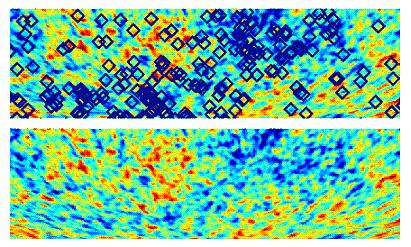Belle Dumas, Physicsweb (translation: Dikla Oren)

Direct link to this page: https://www.hayadan.org.il/wmap080204.html
Many astronomers believe that most of the universe consists of cold "dark matter" and "dark energy". This model was further supported by measurements of the cosmic background radiation. Now, on the other hand, a group of astrophysicists from the United Kingdom has found that it is possible that the cosmic background radiation - the "echo" from the Big Bang in the fields of microwave radiation - has changed or "broken down" in its passage through galaxy clusters on its way to Earth. The findings may undermine previous evidence for both dark matter and dark energy.
The cosmic background radiation provides a picture of the universe roughly 400,000 years after the Big Bang. At this point in time, the universe has cooled enough to allow atoms to form, so there are no more free electrons left to scatter the photons that were created in the young universe. Any change or anisotropy (the meaning of isotropy is the same at every point, that is, at every point that is measured the same result is obtained. Anisotropy is the opposite situation, in which there is no identity between the different measurement points) in the temperature of the cosmic background radiation reflects changes in the density of matter in the universe at that time.
The fluctuations in temperature can be expressed as a sum of physical harmonics. Astrophysicists plot the relative strength of these harmonics as a function of angle. The height and location of these high points of the "intensity spectrum" are related to astrophysical properties of the universe.
Information collected in the first year of operation by NASA's WMAP (Wilkinson Microwave Anisotropy Probe) satellite and presented in February 2003 supports the accepted harmonic model of the universe. This model claims that the universe consists of a cocktail of 5% normal matter, 25% undetectable dark matter and 70% dark energy, the origin of which is unknown.
Now, Tom Shanks and his colleagues at Durham University have conducted a new analysis of the WMAP data by looking at places in the sky where galaxy clusters are abundant. They found that the location of these clusters generally coincided with the locations of points where temperatures were lower in the cosmic background radiation data.
The team claims, the reason may lie in hot gas in the galaxy clusters, which scattered the cosmic background radiation and distorted the spectrum of the background radiation. This effect, called the Soniav-Zeldovich effect, can lower the temperature of the cosmic background radiation. The WMAP scientists themselves have long reported the discovery of the effect near the centers of galaxy clusters.
Shanks and his colleagues now believe that the deformation may affect up to one degree in the sky - a much larger area than discovered so far. This means that there is a possibility that the first and largest peak in the power spectrum graph was affected by the effect. So far, the Soniav-Zeldovich effect has only been observed around much smaller angles. "Since the first peak is the one that provides evidence for the existence of cold dark matter in the universe, any problem here could weaken the evidence for a universe containing dark matter and dark energy," Shanks told Physics Web.
The team now plans to look for the effect in more distant galaxy clusters with additional data from WMAP and the Planck Surveyor, due to launch towards the end of this decade.
Link to the original article on Physics Web
Astrophysics expert - the universe
https://www.hayadan.org.il/BuildaGate4/general2/data_card.php?Cat=~~~755704729~~~60&SiteName=hayadan
